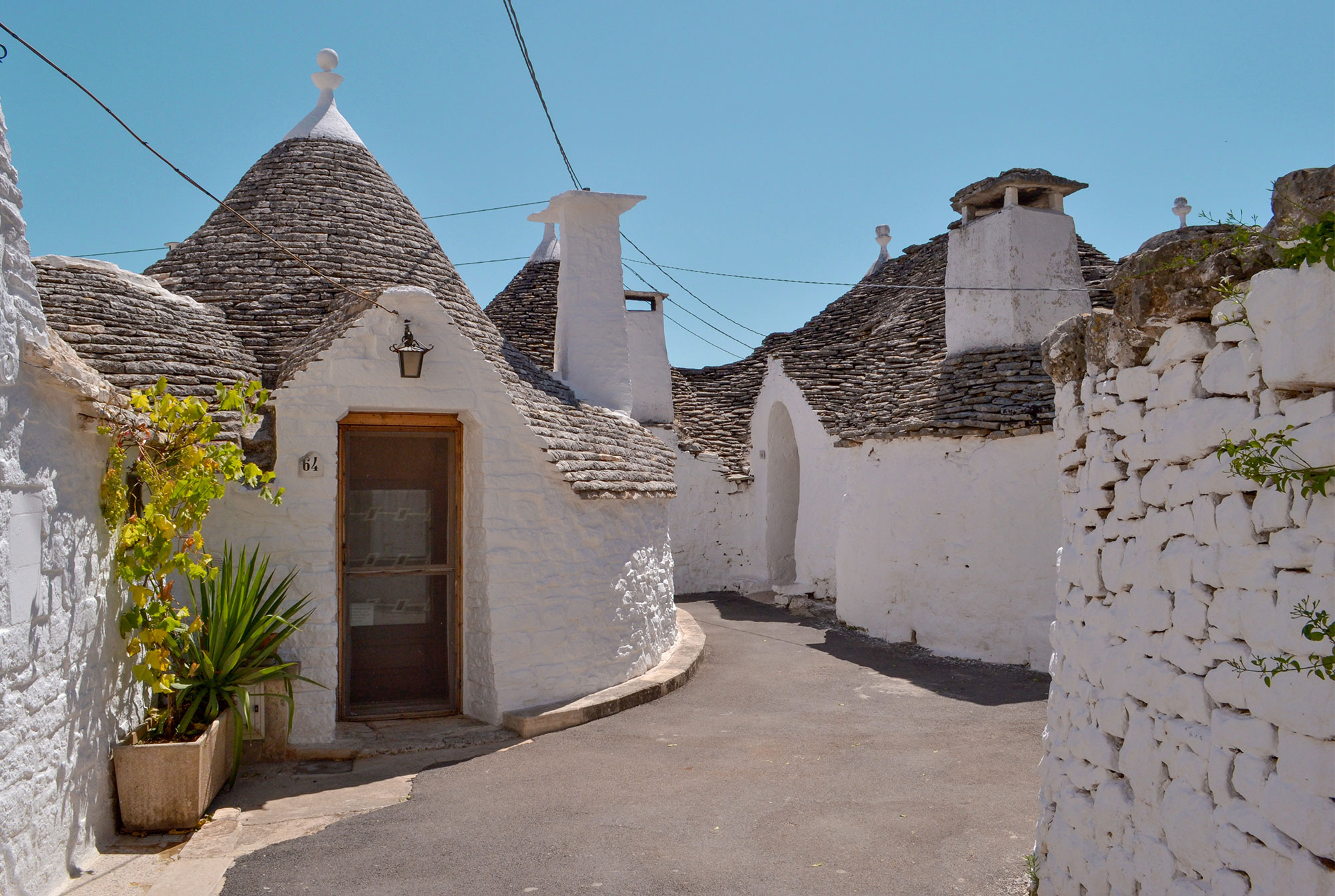
The domed architecture of Italian trulli villages
The Apulia region is located in the southeast of Italy and forms the "heel" of the boot-shaped peninsula. In addition to dreamy coasts and gentle hilly landscapes, there is an Apulian specialty to discover in the region that you might not expect to find in Italy.
So many people may be surprised by the sight of a so-called "Trulli" village: There are numerous stone houses here, which have a pointed architecture. The traditional stone houses (in the singular: "trullo", from the ancient Greek word "τρούλος" for "dome") houses look back on a long history and tradition in the region.

The timeless trulli villages of the Itria Valley
The history of the oldest trulli dates back to the 16th century. A typical trullo is a corbelled vaulted building made of dry masonry, in which no mortar is used at all. Whitewashed walls and dark quarry stone roofs give the trulli their typical appearance. Today, the extraordinary cottages can be found not only in Alberobello, not far from the metropolis of Bali, but also in nearby villages such as Locorotondo, Martina Franca and Cisternino. In Alberobello alone there are more than 1.500 almost perfectly preserved trulli houses.
A clever design that saves taxes
The reason for the great popularity of the buildings was on the one hand the abundance of stones in the region that were needed for the construction and on the other hand the special dry stone construction method. Because thanks to this special construction method without mortar, it was comparatively easy to dismantle the houses again. A measure that is probably due to a deception. When Count Giangirolamo II Acquaviva d'Aragona commissioned the construction of trulli houses on a large scale in the 17th century, he primarily wanted to save on taxes. So he called on the population to build without cement and mortar and only with stone. This had the advantage that, in the event of a royal inspection, the houses could be easily dismantled and later rebuilt. In this way, the Count cleverly saved taxes that the Kingdom of Naples levied on the construction of new colonies at the time.

Pleasantly cool in summer, warm for long periods of time in winter
What is also special is that there is a cavity between the inner and outer stone walls of the houses, which is typically filled with earth and stones. This construction ensures that there is a pleasant climate in the trulli all year round. In summer, the thick walls made of solid natural stone and the tiny windows offer sufficient protection against the heat of Puglia. In winter it stays pleasantly warm for a long time. Thanks to this optimal thermoregulation, it is still possible today to do without the installation of an environmentally harmful air conditioning system in the trulli.
The roofs also impress with their sophisticated two-layer construction. The interior lining called "Chianche" consists of limestone slabs that are arranged in a circle and are finished with a stone. The outer cladding features impermeable, small “chiancarelle” panels that form a cone. A cornice protrudes from the roof, capable of collecting rainwater in the surrounding cisterns. Another proof that the "Mastri Trullari" - the master builders who are responsible for the construction of the houses and who pass on their knowledge from generation to generation - always live in conscious harmony with nature.
Whether as a dwelling or shelter for agricultural equipment and animals - the trulli were used in the countryside for a long time in a variety of ways. Decorative battlements are often enthroned above the domes of the roofs, which are supposed to keep evil spirits and negative energies away. Some roofs were also painted with white ash religious or traditional symbols.


A UNESCO-worthy example of spontaneous architecture
As an "extraordinary testimony to dry stone construction" and an example of "spontaneous architecture", the trulli houses of Alberobello have been a UNESCO World Heritage Site for 25 years now. Since then, the former "poor people's houses" have enjoyed more respect again. Many Italians have rediscovered the potential of the wondrous houses for themselves. Lined up and connected to each other, the trulli are now increasingly being used as residential buildings and some are even rented out as holiday apartments.
Borgo Fianco a Fianco: Sustainable accommodation in a trulli house
So also the "Borgo Fianco a Fianco“. The hosts have converted the building into a luxurious holiday villa with several holiday apartments, including two trulli. With a sea view and a spacious outdoor area including a cistern, in which you can even swim, you can spend a magical holiday with your dearest friends and family in a very special atmosphere.



Albergo Diffuso: Visit to a “Fragmented Hotel”
Another ideal starting point to visit one of the different trulli villages is also the “Albergo diffuse' in Locorotondo. The individual accommodations are spread over the picturesque old town of Locorotondo like a kind of “fragmented hotel”. The hosts made good use of the vacancies in the village by breathing life back into the accommodation. Today, one can enjoy the cosiness of one's own home along with the amenities of a hotel.
A visit to one of the trulli villages is definitely recommended. Here it almost seems as if time has stood still here. The nice thing: The trulli villages are only a few kilometers apart. So you can easily visit all the villages within a very short time. Of course, there is always more time to spend. In any case, it is great fun to immerse yourself in the authentic village life of Apulia with this special story during your holiday.



Lisa Klakow
Lisa helped set up the Good Travel Blog and will write for us as a freelance author in the future. She is passionate about traveling and dancing around the world with a small ecological footprint.






COMMENT